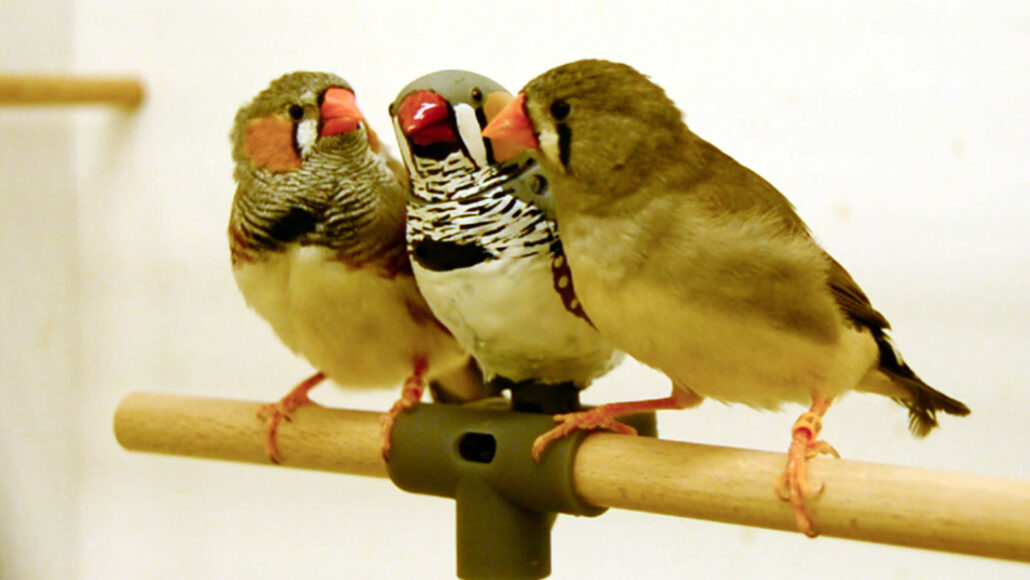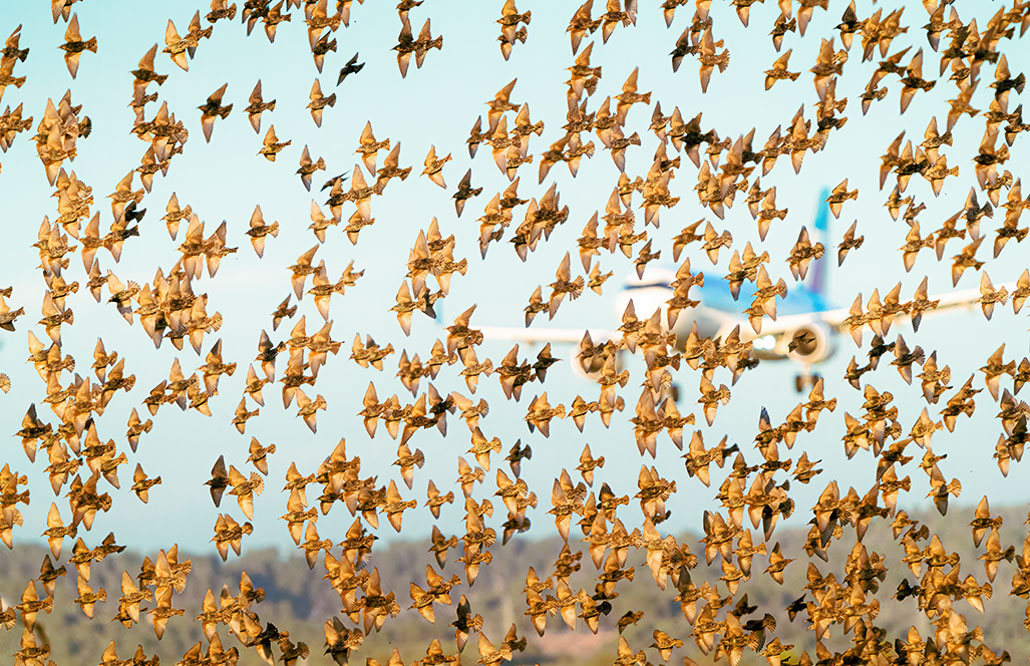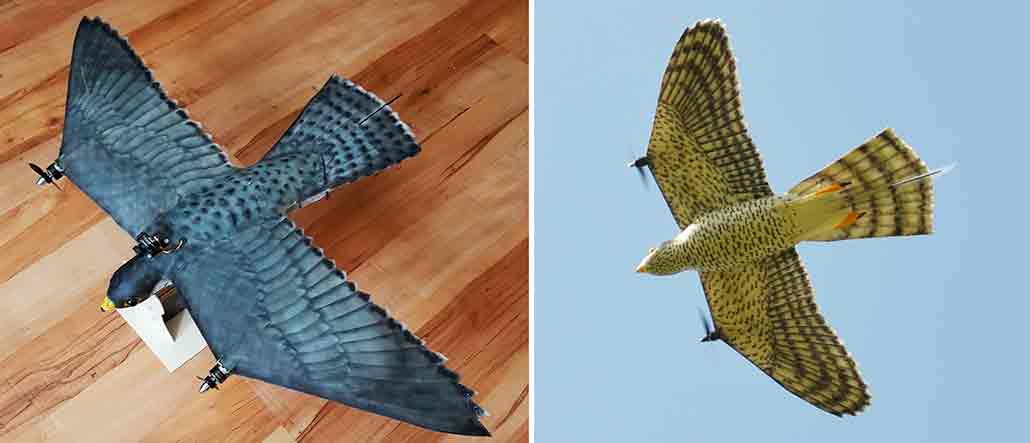Meet robots on a mission to help birds
These gadgets were inspired by the wildlife they were designed to benefit

RoboFinch, a robotic singing tutor for birds, sits on a perch between two real zebra finches, a male (left) and a female (right). RoboFinch’s designers used coils from toy birds to make the beak chatter and head swivel.
Ralph Simon
Two zebra finches sit on a wooden perch. The small songbirds with orange cheeks and black-and-white striped throats normally live in Australia’s dry grasslands. But this pair at Leiden University in the Netherlands is getting a tutoring session. They listen intently to an intricate melody formed of trills and chirps from their feathered instructor. But this singing teacher isn’t a bird. Meet RoboFinch.
RoboFinch is a robotic singing coach for birds. Researchers designed RoboFinch to study what young songbirds need to see and hear to better learn their tunes. Such robots could one day help rare birds survive. RoboFinch is one of several new robots that mimic wildlife to help solve problems.
People have been mimicking birds in design for hundreds of years. Famed artist-scientist Leonardo Da Vinci noted as early as the 1480s that birds could inspire flying machines. Today, birds inspire robots. Festo, a German company based in Esslingen, has developed small, flying Bionic Swifts. One day, these bots may keep track of materials moving through factory production lines. Another team has designed a feathered robotic bird wing that may pave the way for flapping drones.
But bird-inspired tech could do more than make humans’ lives and work easier. Researchers are now creating robots that look, sound or act like birds to study and protect the creatures. One group, for instance, wants to understand how birds learn their distinctive melodies. Others are enhancing drones to protect birds from airplane collisions. Inspired by several tree-dwelling critters, yet another bot may even help future scientists protect the habitats in which birds live.
Chorus lessons
Young male zebra finches learn to communicate by listening to adults. In the lab, researchers have found that these songbirds can learn from audio recordings. But zebra finches learn better when they listen to live male finches, notes Ralph Simon. He studies bioacoustics — how animals make and use sounds — at the Nuremberg Zoo in Germany. Simon is part of the team that built RoboFinch.
His group wanted to know how being around adult males helped young finches learn. Was it the social interaction? Or did they watch their elders’ beak and head movements?
To find out, the researchers built six bird robots. They also recorded high-speed video of adult males to analyze how their beaks move when they sing. The researchers then programmed their robots to mimic those beak movements. “A lot of people thought we would never [make] a robot that moves its beak so fast,” Simon recalls. Finally, the researchers painted their RoboFinches the same hues as the real birds.
Quick like a finch
Then it was time for chorus practice.
In one experiment, the team divided 45 young finches into four groups. Some only heard recordings of finch songs played by a speaker. Others listened with female birds that weren’t singing. This was to study whether song learning depended on social interactions. RoboFinches taught the two other groups of chicks. The birdsongs played from a speaker right behind the robots. And the robots’ beaks moved either in or out of sync with the songs. That allowed the team to investigate whether beak or head movements aid song learning.
Paying attention?
Not all finches learned their tutors’ tunes. But birds housed with RoboFinches eventually spent most of their time near the robot and its speaker. “Almost immediately, they became interested in [RoboFinch],” says Simon. “And then when it sang, they approached it within a few minutes.”
The researchers tallied up the amount of time finches spent near the sound source, either a RoboFinch with a speaker or just a speaker. During the first week, finches living with a RoboFinch whose song was in sync with its beak motions spent 27 percent of their time perching near the robot. Those caged with a robot playing songs out of sync were less keen. They only spent 5 percent of their time near the setup during the first week. Finches that heard only the audio without RoboFinch or female birds spent even less time around the sound source.
Young finches partnered with RoboFinches sang less while the songs played. This was especially true when the robots’ beaks moved in sync with the songs. Those paired with a female also sang less while hearing songs.
The young finches seemed to pay close attention to the robots’ movements during training sessions, the researchers say. When a RoboFinch started singing, the birds often stopped what they were doing to approach it. Scientists have observed similar behaviors in wild finches learning from live tutors.
The team shared its findings in the April 2023 issue of Methods in Ecology and Evolution. The group also shared instructions on how to make RoboFinch. Simon hopes researchers will adapt this approach to building robots of other species, too.
Such robots might one day help orphaned birds, says Heather Williams. A behavioral ecologist, she studies bird songs at Williams College in Williamstown, Mass. Chicks become strongly attached to whoever feeds or interacts with them, Williams says. She did not work on RoboFinch. But maybe future bird-bots could one day help critically endangered birds reared in captivity, she says. Orphaned chicks could attach to robots who could act as choral mentors.
Singing robo-birds could also be placed in the wild to teach endangered birds how to sing. If there aren’t enough role models in the wild, scientists worry, young birds may not learn their characteristic calls. This may already be happening with some species, such as regent honeyeaters. Without instruction, such avians risk “losing the species’ song,” Williams concludes.

Air-traffic control
In some locales, too many feathered friends can pose a danger to people. Consider when birds collide with airplanes. Between 1990 and 2022, more than 260,000 collisions between civilian planes and birds were reported in the United States.
To help clear the air, engineers in the Netherlands at the University of Groningen have built a flying robot. The researchers designed their robot to look like a peregrine falcon — a bird that hunts a broad range of bird species all over the world. With its life-like wings and tail, the robot sports the same gray feathers and speckled underside as its real-life counterpart. Fashioned from fiberglass and rigid plastic, this faux bird of prey is called RobotFalcon.
Bird species around airports should view the bot as a threat, says Groningen biologist Charlotte Hemelrijk. She’s one of the robot’s designers. It runs on two propellers that are attached to the fronts of its wings. Video relayed from a camera on its head allows drone pilots to steer the high-flying device.
Hemelrijk’s team tested how well RobotFalcon scared away birds commonly found at airports. These included starlings, gulls, lapwings and corvids, such as crows and jackdaws. They compared RobotFalcon’s performance with how well a regular drone fared at shooing away such birds. Sometimes the machines descended on birds from up high. Other times they soared up from near the ground. Once the flock took flight, the device chased after the birds.
The chase was deemed successful if the device shooed birds to at least one kilometer (0.6 mile) away. The researchers also observed whether the birds returned within two hours of being chased off.

RobotFalcon was better than the drone at keeping birds away. This bird bot cleared all 54 targeted flocks within five minutes of being deployed. Half of the time, RobotFalcon cleared the fields in just over 60 seconds. Birds also fled sooner when RobotFalcon came at them from above, like a real falcon predator would.
The regular drone cleared about 80 percent of its fields within five minutes. Half of the 56 flocks it targeted were cleared within two minutes — twice as long as it took RobotFalcon. The drone also proved less effective at keeping birds airborne. Birds chased by the regular drone were more likely to land back in the field than the ones that encountered RobotFalcon.
The team also compared RobotFalcon’s results with other methods used to shoo birds, such as small explosives or recordings of the same species’ distress calls. These are sometimes used at Leeuwarden Airbase in the Netherlands. The robot encouraged most birds to stay away longer than these other tactics.
Hemelrijk’s team shared its findings in the Journal of the Royal Society Interface in 2022.
Many birds have a deep fear of predators etched into their brain, says Paolo Segre. He studies biomechanics at the University of Wisconsin-Green Bay. But we don’t understand well how birds decide what poses a threat, he says. “Something about RobotFalcon makes birds think that it is a real falcon,” he notes — “and more of a threat than other human-made objects.” How birds respond may even differ by species. For instance, some birds, such as crows and rooks, returned an hour after being scared away by distress calls or RobotFalcon.
Currently, airports use a range of drastic tactics to evict occupying birds. They might shine blinding lights at them, shoot them or release live falcons to hunt them down. In contrast, Hemelrijk notes, RobotFalcon “is an animal-friendly method.”

A perching spy
High-flying drones can help researchers map and study animals across wide areas. For instance, these machines can count breeding colonies of water birds, find rare rainforest monkeys and even collect whale snot! But hard-to-reach places — such as under a forest canopy — can challenge drones, notes Peter Zheng. This roboticist led a team that has now designed a robot to fill that niche. Zheng works in England at Imperial College London.
Drones waste a lot of battery power staying in the air. By perching, a new type can collect data for longer periods than regular drones. And, adds Zheng, “the longer you can stay in one place, the better.”
To aid it in spying from trees, his team’s new robot changes shape to switch between flying and perching.
Four propellers allow the robot to navigate to a high spot. As the robot prepares to land, a motor pulls on a series of strings. They trigger an arm at the robot’s front to curl around a branch. Once the drone has latched on, the motor shuts off. The clasping arm now holds the bot securely in place.
The researchers were inspired by tree-dwelling animals, such as sloths and squirrels. Such animals use their arms in unique ways to grasp trees and stay up high. But the robot looks like neither a sloth nor a squirrel, Zheng says. And in one way, the robot mimics what birds do when they perch. Steel spines line the robot’s grasping arms. Like bird talons, these spikes latch onto tree bark. Zheng’s group shared its design January 23 in Scientific Reports.
While the drone perches — prolonging its battery life — equipment on board could snoop on wildlife or its habitat. Microphones, for instance, might record bird songs or monkey calls. Cameras could snap pictures while online sensors monitor humidity and temperature. What makes this new forest spy special, Zheng says, “is that it can stay on trees for a very long time.”
“The Sloth”
Are there risks to deploying bird robots?
Recruiting robots as conservation aids is still fairly new. Some of the earliest of these eco-bots were makeshift drones built to monitor wildlife in 2011. Since then, such devices have come a long way, Segre notes. Many small ones are “widely available, easy to fly and highly customizable.”
Still, scientists aren’t sure how drones and other robotic tech might affect birds’ behavior.
Some studies suggest that birds aren’t bothered by drones. But others have found that consumer drones can cause stress. Raptors, such as eagles and owls, may even attack drones to protect their territories. Researchers have also observed that shorebirds (such as American oystercatchers and the endangered piping plover) may try to chase drones away from their nests. This leaves their young vulnerable to predators.
But finding ways to study birds safely with robots could offer benefits. One 2018 report by BirdLife International found that four in every 10 bird species worldwide are in decline. North America, alone, has lost nearly 3 billion individual birds since 1970, according to a 2019 study in Science. And researchers are looking for any tools that could help address declining numbers of birds worldwide.
Today’s robots probably can’t collect all the detailed data on animal behavior that ecologists want, Zheng notes. The devices would likely spook the creatures they are supposed to spy on if they got too close, for example. And in general, robotics tends to focus on cutting-edge technologies. These may not be practical in the wild.
Still, whether it’s singing finches or perching drones, a new wave of tech is taking cues from nature. These devices can tap into the unique abilities of birds and other tree-dwelling critters to help both humans and wildlife. Borrowing tricks from animals could make robots more useful, too. “Nature and animals are excellent at adapting to their environment,” Zheng says. For roboticists, “there are many lessons to be learned from nature through biomimicry.”







